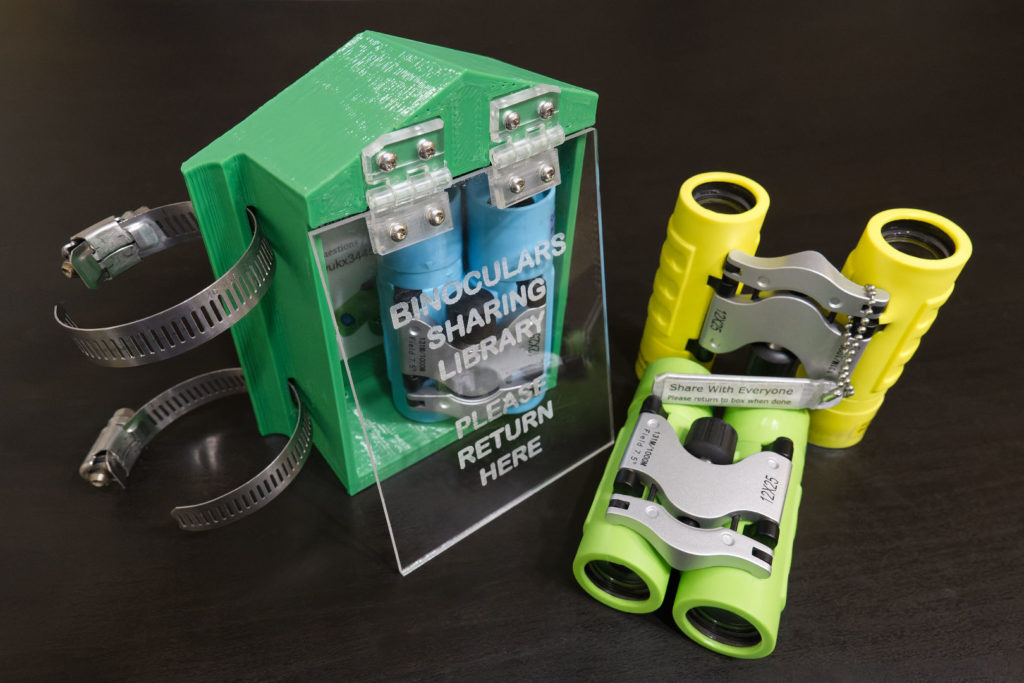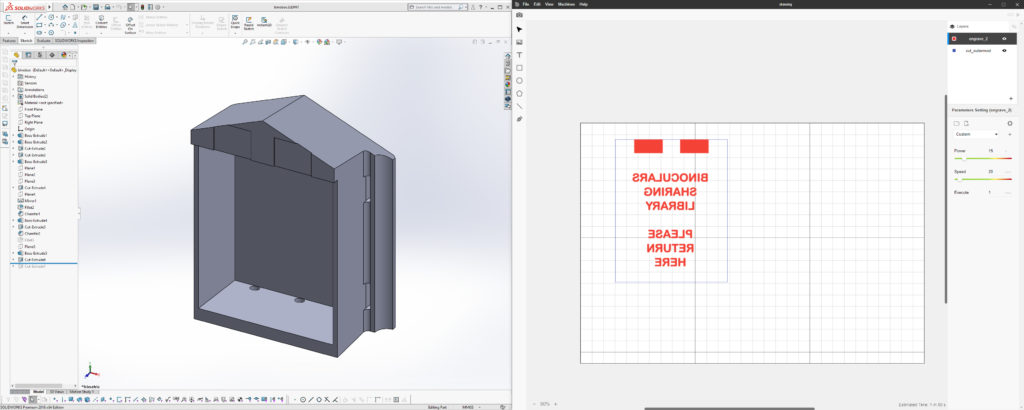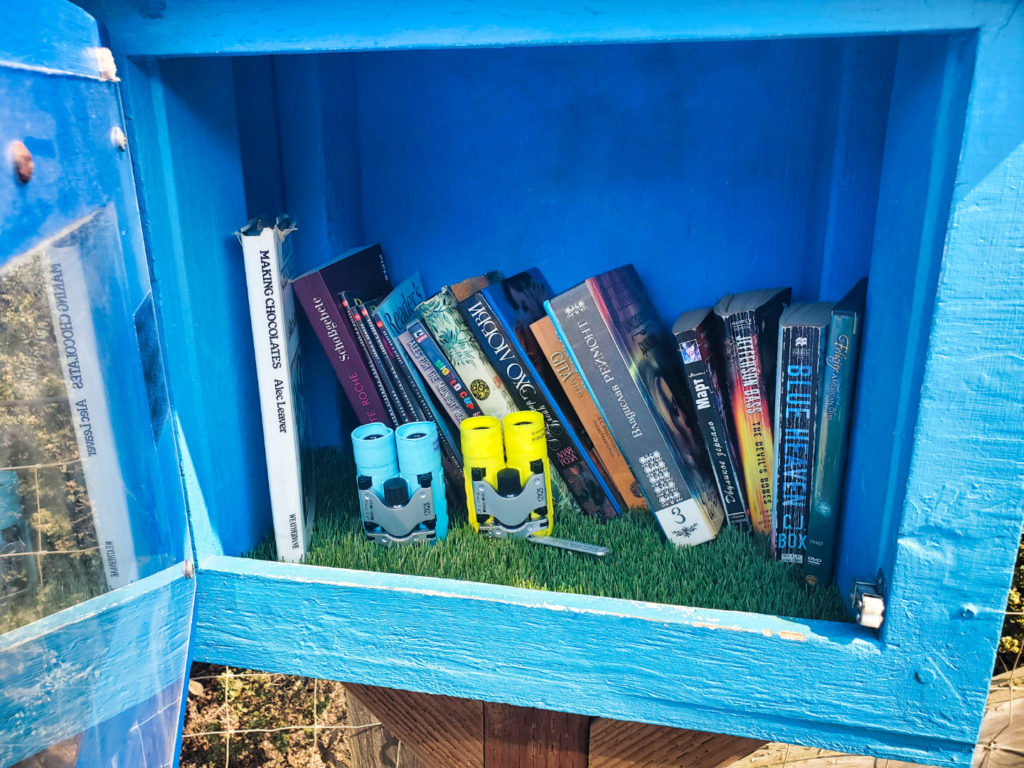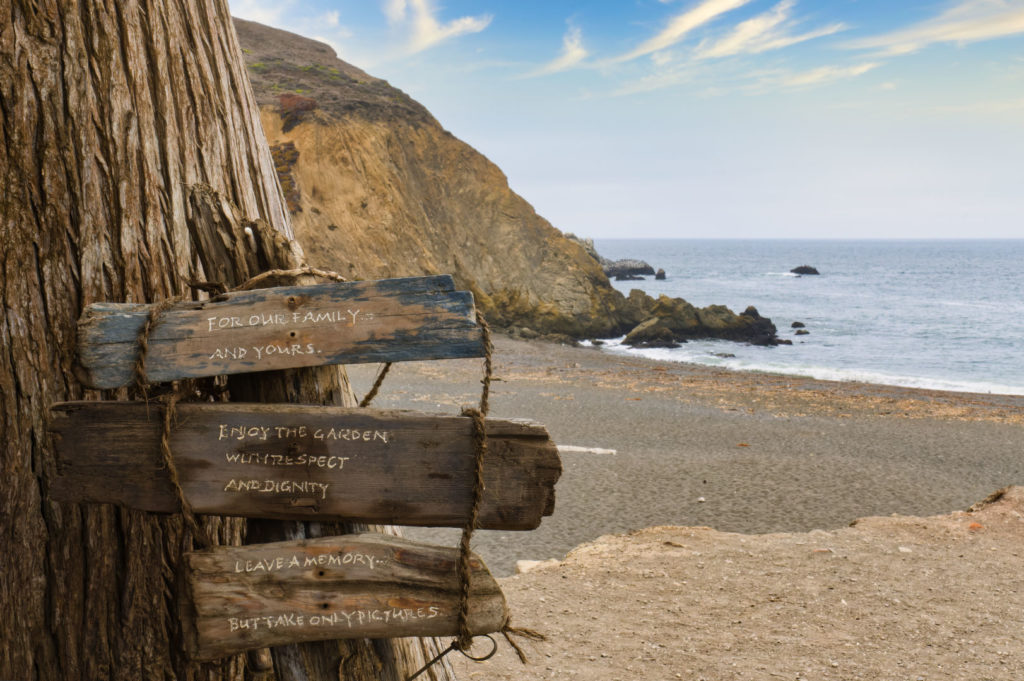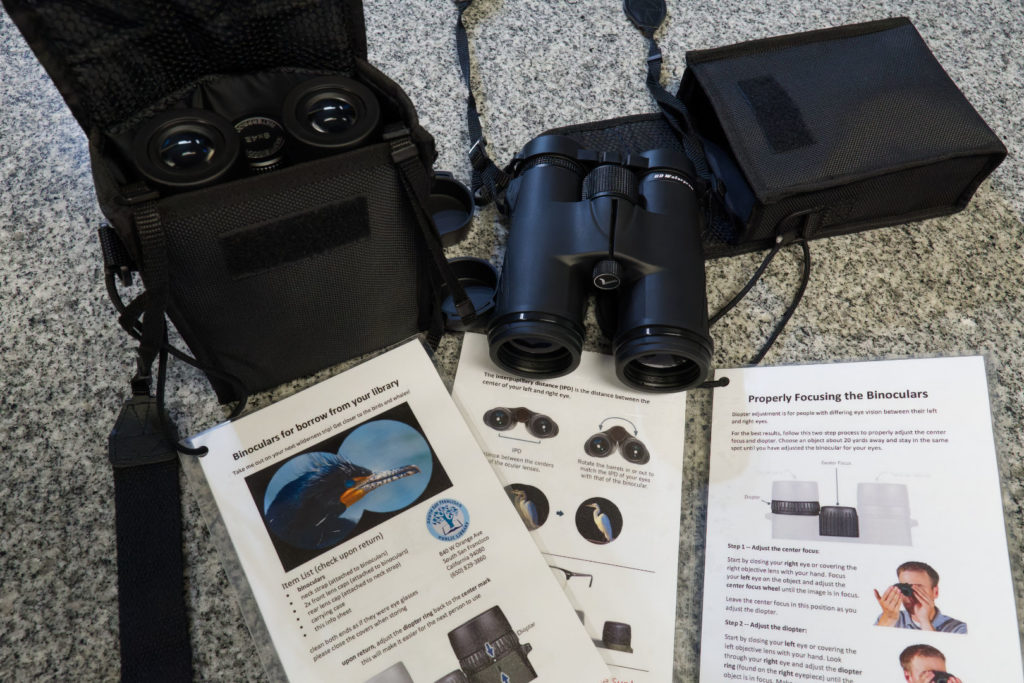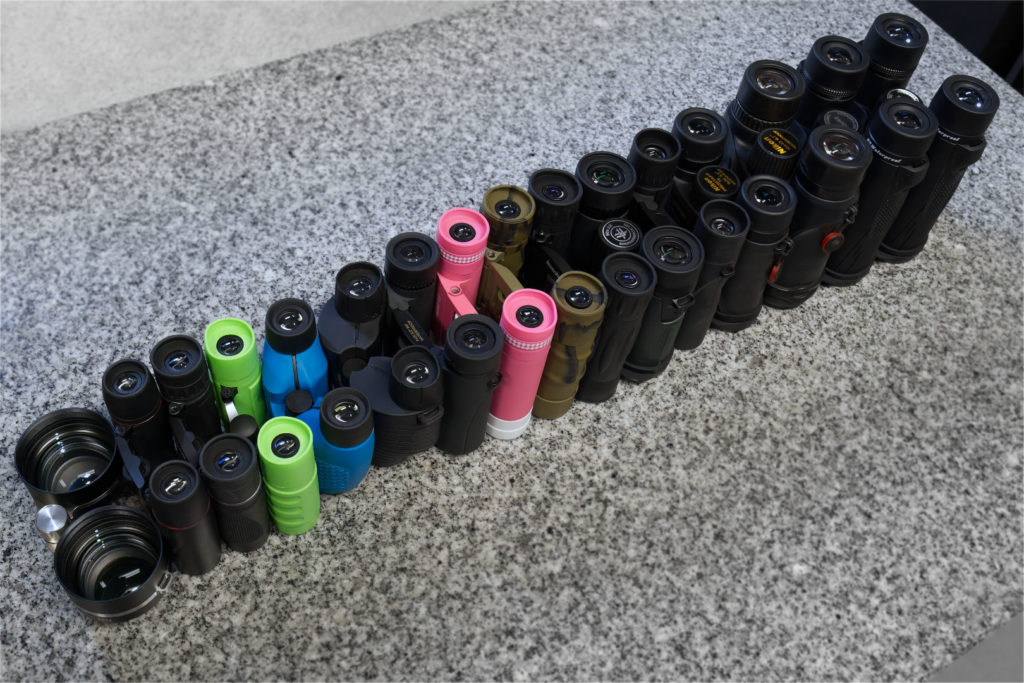You might be enjoying a trip to the Pacific coast one day, hoping to see some whales, and stumble upon this…
just felt like doing a little nice thing for the world…
…in my own way, proudly made on my Hephaestus and my Beamo
Welcome to the trail leading up to Mori Point! One of my favorite places…
Bonus: some gifts to the library I volunteer at
During the madness that is 2020, I was fortunate enough to be able to enjoy the outdoors more. At one point, I got some really nice binoculars, and they felt like a superpower! I have been letting people use my binoculars at a local whale-watching spot, and I’ve gotten some great reactions. So I decided that some binoculars should just be there for everybody to use (no coins required!). Conveniently, there’s a fence post up on the cliff, and also a little-free-library at the hiking trail entrance!
For the fence post, I designed a little house to for the binoculars to live in! It’s made of 3D printed PETG plastic and the cover is clear acrylic plastic with the text laser engraved.
Of course I totally expect these to be stolen, broken, vandalized, bitten, or thrown off the cliff… I shopped around for some small cheap $20 binoculars, cheap since I’ll be replacing them quite frequently. In my shopping, I got curious about some playfully coloured ones that claim to have 12x zoom. What happened surprised me: they worked better that just “good”.
For some context behind my opinion, my own binoculars are 10×42 Nikon Monarch 7 that costs about $500. They are a superpower to me, literally life changing. The width and sharpness of the view it provides feels like entering another world where I can touch the animals that I would’ve not even noticed normally. I picked them because a park ranger once let me use a pair to see some elephant seals fighting. I’ve had other bird-watchers point out “I see you have good binoculars” when I carry them. And Nikon absolutely NAILED the brand with the name Monarch, what a beautiful creature that befits the name of binoculars.
Please excuse my dramatic appraisal, they are not one of the better German brands, but they are still that good to me.
I liked the pocket size of these kiddo-binos. There are local parks with amazing wildlife where I don’t want to carry my humongous 10×42 around, since it’s too close to people’s homes. Now that I know the kiddo-binos are decent, I wanted something that’s not such a fluorescent colour. This turned out to be quite difficult at the $20 price point! I went on this investigative adventure, more like a shopping spree…
Meet the Family!
I know this looks crazy, but everything that I don’t keep will get donated one way or another.
Below are individual reviews of these binoculars.
Nikon Monarch 7 in 10×42
These feel like a superpower. Literally zero problems. The field of view makes you forget you are using binoculars. The sharpness is one of the best before moving up the price ladder to something that features field-flattening. Colours are accurate and contrast is excellent. The brightness is able to show you the Andromeda Galaxy and The Great Orion Nebula at night. In certain lighting conditions, I consider these twice as bright as some of the 25mm binoculars I’ve compared it against.
The build quality inspires enough confidence for me to hip-sling it while traversing very on-all-fours locations, and I clean it off with my kitchen faucet.
While the 42mm size is quite the standard general purpose size, the size and brightness is something a new user will need to get used to. I would recommend this as a first time buy if you are already sure you have a passion for nature.
no-name brand kiddo-binos, 12×25
These are the ones that started this whole shopping spree. They cost about $20, and advertised as 12×25. In reality, they are 8×21, so there’s a ton of false advertising there. I’m forgiving them because the optical performance is good enough, and nobody actually needs 12x zoom in kids binoculars.
The only optical problem is significant pincushion distortion. Brightness, sharpness, contrast, colour, all better than several other ones
at the $20 price point . It doesn’t approach any name-brand ones but that doesn’t matter, I feel like it’s still good enough for my own personal use if I forget my Monarch.
Hell, I think distortion might look cool to a kid. I would’ve had fun manipulating my view with it.
The real drawback here is the mechanical design. The focusing knob is not supported at both ends, and is held in place with a grub screw. It wiggles, and the whole mechanism wiggles with it, so the tolerances are not very tight. I don’t think these will last very long.
Nikon Aculon A30, 10×25
These were on sale for about $46. I trusted Nikon to still give me good optical performance even at a low price. I was right, but the big problem here is that… I just assumed that these are 25mm and have a twin hinge folding mechanism, they would fit in my pocket. WRONG!
These don’t fit in my pocket when folded, the bridge design is too thick and the overall length is very long. I feel like this product is deceptive. In reality, unfolded, these are the same size as 30mm binoculars.
But since it’s dimmer, less contrast, with a narrower FOV, and not waterproof, I don’t see a reason to own them at all.
It is a good quality product that feels like it can take a beating. I just don’t have a reason to want these. So these now live in my car’s glove box. My friends can use it to read bumper stickers and I can use it to check status on traffic jams. It’s hilarious to see the guy in front of me floor it when he notices my friend using binoculars.
Nikon Trailblazer, 8×25
I got this after being frustrated with the Aculon A30’s size, I actually went to a in-person sports store so I can make sure it fits in my pocket. Price is at around $75, which makes it compete with some decent full sized binoculars (read what I say about the SV47).
The little bump in price from the Aculon gets me more FOV and waterproofing on top of already good optic performance.
It still has a problem, the eyecups are the twist-up type, but they don’t have detents. It’s actually loose enough to move if your face touches it, so they are useless. I solved this problem by removing the eyecups, and inserting some tape…
Importantly, these are the only 25mm category binoculars in my inventory that might be a good experience for people wearing glasses. The design has a long eye relief even with the cups down, yet, I can still stick my face right into it, also with the cups down. This isn’t usually possible with bigger binoculars.
If I had found unacceptable problems with the Trailblazer’s optics, the next contender in the same size would’ve been the Zeiss Terra. But at the Zeiss price, it would’ve been quite silly to have in my collection, being more expensive than a Prostaff or Diamondback.
Nikon Prostaff 7S, 8×30
I needed a second pair of general purpose binoculars for friends who accompany me on outings. I picked a smaller size as I actually feel my Monarch’s size is sometimes overkill. So I took this chance to check out the Prostaff family and compare it against the Monarch. It’s has good performance and basically the same build quality. It’s FOV is slightly smaller, you feel like you are definitely looking through binoculars. But hey, these are damn good binoculars.
The lens caps that come with the Prostaff absolutely suck
It’s also missing a tripod mount, a weird ask for 30mm sized binoculars but still might come in handy.
I would rather have the Vortex Diamondback HD at this price point, as it has a wider FOV and better accessories. But the Prostaff has excellent glare and flare control, just like my Monarch, you have to almost look into the light before you notice glaring and flaring. The Diamondback is not good in this aspect when compared against the Prostaff.
Vortex Diamondback HD, 10×32
Holding this thing is an
EXPERIENCE .
It’s like they prototyped with steel pipes and decided to stick with that feel, and even texture. Vortex actually made sure there’s a satisfying clank when you fold/unfold the bridge to its limits. The eyecups click like a mechanical keyboard. I’m confident I can use it as a weapon if I had to.
It feels like the focus knob has two modes for coarse and fine tuning. Once you start to reverse your adjustment, the spring tension feels softer. It feels like backlash, but it’s not backlash, because the optics is moving without any lag. It feels like a clever way of making fine adjustments easier once you’ve done your coarse adjustments. My bigger Nikon binoculars have a tighter knob in general, and my smaller ones do have the same soft feeling, but not so exaggerated for me to notice.
The carrying case it came with is something I would’ve paid extra for
OK OK OK we should be talking about optics…
Diamondback’s FOV is beating the Prostaff 7S for sure. This is the main reason why I went for it.
As for how the image actually looks? I put in a lot of effort into evaluating this one, due to its hype… I gotta say: the Nikon Monarch 7 is double the price, and now I feel like it’s justified. On a black and white text reading test, it’s hard to declare a winner. But in an outdoor test looking at evergreen leaves, the Monarch 7 has a clear advantage. I believe this means the Monarch provides better contrast.
On the plus side, the Diamondback gives a noticeably deeper depth of field at close ranges. Looking at a tree at close range, about 70 feet and closer, the Diamondback makes the tree branches and leaves look more 3D than my Monarch. Another way of saying this is the zone that your eyes can focus between is bigger when using the Diamondback. Using fake numbers here, but if I focused on something at 50 feet, with the Diamondback, I can see things sharply between 40 and 60 feet, but with the Monarch, I can see things sharply between 42 and 58 feet. If I use the Monarch first, then switch to the Diamondback, I can actually tell that my eyes start to overshoot its natural responses until they are reacclimated. But I can’t make guarantees about the effect if you picked 10×42 Diamondback instead of 10×32 Diamondback, testing against my 25mm binoculars, I can’t actually determine a correlation to the lens size vs depth of field (with cameras, the aperture f-stop determines this, it’s basically the bokeh effect). The effect is only dramatically different enough on the Diamondback for me to even notice, which might also be because of the wider FOV, as it is now my second widest FOV available to test.
The Diamondback will glare and flare a bit earlier than my Monarch.
It’s easy for me to use because the eyecups are the correct height for me once they are extended. But the focus knob is in the opposite direction as my Nikon collection, so it takes getting used to and difficult to switch back and forth.
Another flaw is that it’s exhibiting a weird ring of reflection beyond the field of view. It’s not affecting the image, it is not making the FOV smaller, but it is a bit distracting. It reminds me of looking down a shiny pipe, and there’s a bit of reflection right at the end where the hole is.
I got this for the times when I didn’t want to use my Monarch, and I can definitely hand it to somebody I care about without feeling like I’m treating them like a sibling. But the extra clarity from the Monarch is making me question if I will ever ditch the Monarch.
Svbony SV47, 10×42 and 8×42
I believe these were supposed to be $50 or $60 but Amazon had them on sale for $23 and I just had to grab them to try. They are 42mm so they are hefty, they don’t feel cheap, there are chonky aluminum parts on it everywhere (but I can’t really “drop test” them so take my opinion here with a grain of salt).
The intention here is to get some “adult” sized ones to be donated to the library I volunteer at, who also provide other healthy lifestyle items.
The image difference between these SV47 and my Monarch is subtle. The image is either darker or warmer, my brain is telling me there’s a difference, but it’s insanely hard to pinpoint. It takes some extreme lighting conditions to notice.
Under typical conditions, the SV47’s view looks fantastic. The image had no problems with sharpness, colours, or contrast. Chromatic aberration does show up a bit earlier than any of the more expensive binoculars I tested. It will glare and flare a bit earlier than my Monarch, earlier than the Diamondback.
The close-focusing ability is not as good, 15 feet, it’s not garbage but I wouldn’t keep these for myself as I like the ability to see up close details. I have examined bird injuries with my Monarch.
There is a tad bit of pincushion distortion, very minimal but I did notice it. This distortion is so subtle that you might not even see straight lines being bent, but if you pan your view across a textured background, you get the bubble feeling.
The SV47 does seem to be a bit harder to use, harder to get my eyes into the right position, harder to get the IPD perfect. Take this opinion with a grain of salt (you should have many grains reading my writing), as I might be simply too used to my Monarch. The eye relief for the SV47 is longer, technically by only 0.5mm, but the Monarch’s eyecups are taller by several mm so that could explain it.
I’m going to say that if these were my first binoculars, I would’ve said “huh, these are good”, but not have considered them a life changing superpower. For $24 they are unbelievably good and a must-buy. For $60… it’s competing against Celestron Outland and I think the SV47 would win that fight. For under $100? It looks like on Amazon it’d compete against Athlon Neos, which might win for the extra $40.
The focus knob is in the opposite direction of my Nikon collection, in the same direction as the Diamondback.
The accessories that came with the SV47 feel cheap, and yet, they feel more useful than the ones that come with Nikon binoculars. For example, the case that Nikon gives out is smooth feeling and nicely padded, but the Svbony case has a zipper pocket where I can put in a cleaning cloth, plus a secondary sling just for the case.
Svbony SV204, 10×25
I got these for $10! Only the pink ones were available for $10 on Amazon’s free one-day shipping. The blue version can be purchased from Svbony for $22 plus shipping from China. Apparently these are made for the 2021 Olympics.
These perform a tad better than the no-name kiddo-binos, the lens is slightly larger and Svbony actually cares about optical design as they are an astronomy company. There is still distortion but a lot less than the other cheapo-binos.
These don’t feel cheap. Instead of a rubber wrapper, these feel like they are metal that have been painted. The focusing mechanism is all-internal, and reminds me of the Trailblazer. The neck strap actually has a thick portion to it so these won’t hurt your skin.
These are winners. I will be buying more of these as replacements for the kiddo-binos, but I can’t do that quickly for the blue version.
Still a bit too long for comfortable pocket carry, that’s just my opinion.
Svbony S10, 8×25 fixed-focus
Fixed-focus! Also known as: focus-free, auto-focusing, permafocus
This type of binoculars are supposed to “just work” without any focus knob at all. So there are no instructions required, which makes them good for kids.
The way they work is that the optics are designed to let your own eyes do the focusing. One upside is that the diopter adjustment matters a lot less. The downside is that, depending on your vision and brain power, it feels WEIRD. Normally, both of your eyes are coordinated in focusing, but now, there’s a chance I’m forcing them to be out of synchronization. I can do it, it looks fine with an incorrect diopter setting, but it feels really weird. I’m afraid to use these for extended durations, I might get headaches.
I think you need good vision for these to work well, and I have no idea if they are good for people with glasses.
The image is good but the FOV is very narrow, very.
I’ll pick up some bigger versions fixed-focus binoculars if I’m going to watch F1 or NASCAR or something like that. But I’m 99% sure I won’t need it for airshows.
Aurosports, 8×22 fixed-focus
Another fixed-focus binocular, cheaper than the Svbony S10, and with playful colour options. It also claims to be waterproof.
Too bad it’s pretty much unusable. The eyecup is shorter without a shroud. It’s very difficult to even get an image out of it since it’s so much harder to align with your eyes. Plus, without the shroud, the eyepiece reflects the image of what’s around you instead of showing you what’s in front. This also indicates that it’s missing an anti-reflection coating, because this problem doesn’t happen with any of my other binoculars without a shroud (eyecups down).
Levenhuk Atom, 12×25
I feel like these are the average $20 pocket binoculars. Optical sharpness is definitely ok, close-focusing ability is better than the SV47. The focusing mechanism is better than the no-name kiddo-binos.
The big problem is the contrast loss when in conditions when you are looking near a light source. While no binoculars can survive looking directly into a light, these ones start to look washed out far earlier than other ones in this price range.
Plus, the rubber molding of the exterior has glitter sparkles embedded.
These won’t go into the garbage, probably Goodwill.
no-name brand, 12×25
In every way identical to the Levenhuk Atom, except… The outer rubber shell seems to be cut by hand with scissors, none of the lines are straight. The camouflage look seems to be applied with a permanent marker.
This purchase was more to confirm that the optical design and optical components might come from the same factory.
Off to Goodwill with ya.
POLDR, 8×21 and 12×25
Both of these go directly into the garbage.
The 12×25 is falsely advertised, it’s just 8×21. It also has a fake ruby coating on the front lens which completely ruins the colour accuracy. There is also some insane lateral fringing.
Straight into the trash, both of these. If the 8×21 actually arrived in working condition, it might’ve gotten a better review than the kiddo-binos, as it’s more durable. Hell, it’s even smaller than my Trailblazer and SV204. It’s a very attractive $20 pocket bino if it wasn’t broken.
Summary
Monarch 7, 10×42: the best I have and most expensive, but well worth the cost
Prostaff 7S, 8×30: good, narrow FOV, better internal reflection control than Diamondback
Diamondback HD, 10×32: good, great build, wider FOV than Prostaff, worse internal reflection, better depth sense
Svbony S47: less than ideal but great for a sale price
The Svbony S204 and Nikon Trailblazer are the winners for the pocket sized category
I’m sorry I didn’t buy any of the German brands, I’m not qualified to upsell $300 pocket binoculars to you
My 2 cents on picking zoom and size
If you are new to binoculars, the default recommendation is 8×42, meaning 8x zoom, 42mm diameter front lens. Zoom matters for how much detail you want to see. The lens diameter matters for seeing in the dark as a larger lens allows more light to enter.
8x zoom is fine for the vast majority of use cases, and is not hard to hold steady.
10x zoom is better for seeing details, but people typically see a more shaky image, as hand tremors also get magnified. However, my personal opinion is that, like any sports, you can get used to it with experience. Plus, your brain is excellent at picking out details from the image even if it is shaking. I started out with 10×42 and I’ve never complained. In certain situations, you can get creative with methods to brace your arms, use your elbows, use your knees, lean on a tree, etc
12x zoom and over is entering “tripod required” territory. This opinion is universal.
If you want to buy large binoculars with 10x zoom, then try it out in a store if you can. Importantly, make sure the eyecups can reach your face when your eyes are correctly positioned. This will allow you to use your face to steady the binoculars slightly more.
42mm front lens diameter is the default recommendation. It allows for a decent amount of extra viewing time after sunset. It also allows for some important stars to be visible even with some sunlight left in the sky.
Picking 30mm instead of 42mm is just a tradeoff between portability and low-light capabilities.
Anything 25mm and lower is just pocket size territory, not for any serious low light use.
Anything 50mm and above is entering astronomy and tripod-required territory.
Larger lens = more cost!
Monoculars are useless. They are harder to hold, harder to focus, and makes your face tired. If you need portability, just get pocket binoculars.
There are scummy companies that put random large numbers into a product name but hide the real magnification. Those supposed “40×60” binoculars are probably only 8×25.
My 2 cents on optical quality evaluations
Please don’t ask me to use a camera to objectively test the optical quality of binoculars. I tried, and I find that it will be nearly impossible to obtain data that’s comparable between binoculars in a fair way. The problems: results are too sensitive to the test setup, cameras suck compared to a human eye, and the camera lens adds too many flaws into the image itself (fine for computers since we can automatically remove those flaws, but not fine for a human eye).
Do not use any photos from binoculars to judge the quality of binoculars! All the videos and photos you see with people taking pictures through binoculars are useless for judging optical performance, unless they are REALLY bad (see my POLDR photo).
I really do feel like my own physical state is affecting my ability to evaluate binoculars. How steady my hands can hold binoculars and how well my eyes can focus is definitely changing throughout the day. I can only tripod-mount one at a time so it’s insanely hard for me to keep these evaluations scientific.
Any advertising for optics that uses video to show you “zoom” is fake, taken with a Nikon Coolpix P1000 camera. The internet is full of scams now. I see plenty of those “pocket telescope” adverts, it’s usually just a crappy 8x monocular.
People will talk about how the image gets softer around the edge of view when reviewing binoculars (and other optical stuff). The sharpness across the whole FOV is an important indicator of optical design quality. Keep in mind, when you are hand holding binoculars and the object to the side isn’t sharp, you can naturally re-aim your binoculars. On a tripod, that’s not possible, so the sharpness around the edges matter more if you plan on using a tripod.
Below $50, ignore all advertising about coatings and prisms. Above $100, demand waterproofing, demand BAK4 prisms (unless you fully understand why you want BK7 prisms instead), demand fully-multi-coated lenses. Phase correction and dielectric coatings on the prisms start to become important at triple digit prices. HD and ED glass also start to make an appearance, but note that while they claim to eliminate chromatic aberration, it’s more about how much contrast they can survive before you start noticing the chromatic aberration, it’s never truly eliminated.
Stop reading any reviews that has affiliate links! They are often written just to drive clicks to the links for money. If you read enough of them, you will start to notice that they mention features as if that feature is somehow exclusive to one item, when in reality, it’s a very common feature. It will look like a comparison, but it’s not, it’s just there to get you to click on the affiliate link.

